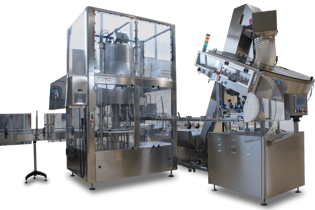
What are they?
The capping machines are devices used in the packaging industry to apply caps on bottles or containers. These machines are essential for securely sealing the contents of bottles, maintaining the freshness, integrity, and safety of the product during transport and storage. Capping machines are commonly used for bottles containing beverages (such as wine, beer, water, juices), food products (sauces, oils), pharmaceuticals, and cosmetics.
The main objective of the capping machine is to attach a cap to the neck of the bottle, creating an airtight seal that prevents the contents from leaking and protects against external contamination. The capping machine must be able to perform this operation quickly and accurately, without damaging the cap or the bottle.
What do we offer?
1. Rotary Head Capping Machines
Operation: These machines are equipped with rotary heads that continuously apply the cap to the bottle while in motion. The bottles are fed in a circular manner and pass under each capping head that rotates and applies the cap.
Features:
They use rotating plates for quick and uniform cap application.
Suitable for high-speed production lines.
Advantages:
High speed, ideal for large production volumes.
Ability to use caps of different materials and shapes.
Disadvantages:
Greater complexity and maintenance compared to other types of capping machines.
Require precise adjustments for caps of different sizes.
2. Fixed Head Capping Machines (or Single Head)
Operation: In these machines, a single head applies the cap to the bottle vertically. The bottle is positioned under the capping head, which applies pressure to apply the cap.
Features:
They use a manual or automatic pressure system to secure the cap.
Ideal for crown caps or screw caps.
Advantages:
Suitable for small to medium-sized productions.
Easy to configure for caps of different sizes.
Disadvantages:
May be slower compared to rotary head capping machines.
May take more time to apply caps on large volumes.
3. Automatic Rotary Head Capping Machines
Operation: Similar to the rotary head machine, but fully automatic. Bottles are transported on a conveyor belt to a capping head that applies the cap with automatic precision.
Features:
Bottles are automatically fed into the machine, and the cap is applied without human intervention.
Found in highly automated production lines.
Advantages:
Very high speed and complete automation.
Ideal for large volume productions.
Disadvantages:
Requires a high initial investment for automation and setup.
Can be expensive in terms of maintenance and repair.
4. Screw Capping Machines (Screw Capper)
Operation: These machines are designed to apply screw caps. The cap is screwed onto the bottle using a system of rotating spindles that turn the cap to secure it tightly onto the bottle.
Features:
Suitable for plastic, glass, or other material bottles.
Can be adjustable for different sizes of screw caps.
Advantages:
Great for bottles with screw caps, commonly used in beverages and food products.
Ensures a tight and secure seal.
Disadvantages:
Not suitable for caps other than screw caps.
May require frequent calibration if using caps of different sizes.
5. Crown Cap Capping Machines (Crown Capper)
Operation: Crown cap cappers apply the classic metal crown cap, which is crimped and folded over the bottle's edge to create a secure closure. The bottle is positioned under a capping head that presses the cap onto the bottle neck.
Features:
Ideal for glass bottles and generally used for alcoholic beverages like beer, carbonated drinks, and other beverages.
The machine uses high pressure to secure the crown cap onto the bottle.
Advantages:
Securely seals bottles so they cannot be opened without damaging the cap.
Robust and durable machines.
Disadvantages:
Cannot be used for caps other than crown caps.
Require regular maintenance to maintain process precision.
6. Press-on Cap Capping Machines (or Push Cap)
Operation: These machines apply a cap that is simply pushed onto the bottle neck, creating a hermetic seal through pressure. They are commonly used for plastic caps or press-on caps.
Features:
Can apply press-on caps on plastic or glass bottles.
Often used in combination with sealing systems to ensure a perfect closure.
Advantages:
Easy and fast, with low technical complexity.
Suitable for small productions or bottles with press-on caps.
Disadvantages:
Not suitable for caps that require a screwing process or complex sealing.
7. Lever Cap Capping Machines (or Lever Capper)
Operation: In this machine, the cap is applied with a lever action, where the cap is inserted into the bottle neck and then secured through a mechanical movement that creates a hermetic seal.
Features:
Widely used for smaller bottles or for manual capping in small productions.
Can be automated for higher production lines.
Advantages:
Good for artisanal production or small series.
Easy to use and less expensive compared to high automation cappers.
Disadvantages:
Not suitable for large production volumes.
Less efficient in very high-speed production lines.

TORQ







